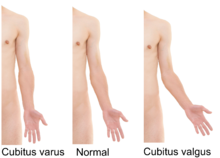Valgus deformity
This article needs additional citations for verification. (July 2013) |
| Valgus deformity | |
|---|---|
| Specialty | Rheumatology |
In orthopedics, a valgus deformity is a condition in which a bone or joint is twisted outward from the center of the body.[1] The opposite deformation, where the twist is toward the center of the body, is called varus. Common causes of valgus knee in adults include arthritis of the knee and trauma.
Terminology
Valgus is a term for outward angulation of the distal segment of a bone or joint. The opposite condition is called Varus, which is a medial deviation of the distal bone.The terms varus and valgus always refer to the direction that the distal segment of the joint points. For a discussion of the etymology of these words, see the entry under varus.
Knee arthritis with valgus knee
Rheumatoid knee commonly presents as valgus knee. Osteoarthritis knee may also sometimes present with valgus deformity though varus deformity is common. Total knee arthroplasty (TKA) to correct valgus deformity is surgically difficult and requires specialized implants called constrained condylar knees.
Examples

- Ankle: talipes valgus (from Latin talus = ankle and pes = foot) — outward turning of the heel, resulting in clubfoot with the person walking on the inner part.
- Elbows: cubitus valgus (from Latin cubitus = elbow) — turned-in elbows
- Foot. pes valgus (from Latin pes = foot) — an outward deviation of the foot at the talocalcaneal or subtalar joint.
- Hand: manus valgus (from Latin manus = hand)
- Hip: coxa valga (from Latin coxa = hip) — the shaft of the femur is bent outward in respect to the neck of the femur. Coxa vara on the other hand is a direct match of above where the neck-shaft angle is reduced(from nearly 135).
- Knee: genu valgum (from Latin genu = knee) — the tibia is turned outward in relation to the femur, resulting in a knock-kneed appearance.
- Toe: hallux valgus (from Latin hallux = big toe) — outward deviation of the big toe toward the second toe.
- Wrist: Madelung's deformity — Wherein the wrist bones are not formed properly due to a genetic disorder.
See also
References
- Canale & Beaty: Campbell's Operative Orthopaedics, 11th ed. - 2007 - Mosby, An Imprint of Elsevier
- Bowed Leg (Varus) and Knock-Knee (Valgus) Malalignment: Everything You Need to Know to Make the Right Treatment Decision-Understanding lower limb malalignment-Tibial osteotomy for bowed legs, Noyes, Frank R. and Barber-Westin, Sue, Amazon Digital Version, Publish Green (October 6, 2013)
